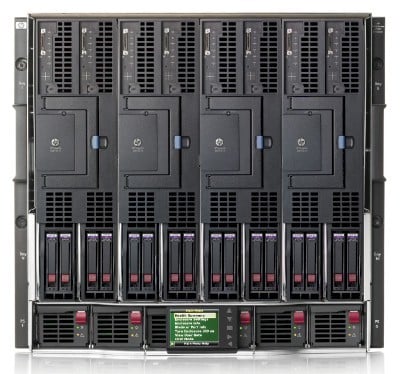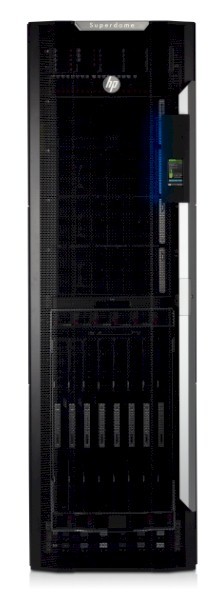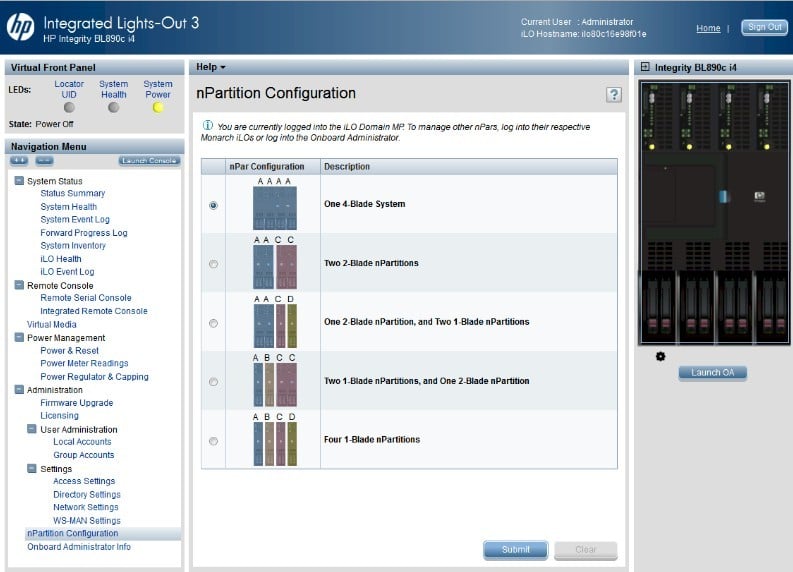Original URL: https://www.theregister.com/2012/11/09/hp_integrity_superdome_itanium_9500/
HP revs up Integrity, Superdomes for Itanium 9500s
Several new leases on life, with an option to buy
Posted in Systems, 9th November 2012 01:17 GMT
Now that Intel's "Poulson" Itanium 9500 processors are out and Oracle is supporting its database on HP-UX 11i v3 running atop those processors, HP CEO Meg Whitman has two fewer things to worry about. The life of Ric Lewis, the new general manager of the Business Critical Systems division who took over that job late last week, is a whole lot easier, as well – now BCS can get back to peddling Itanium-based servers and boosting HP's bottom line.
The Itanium 9500s were launched on Thursday at a double-whammy event that featured Intel execs and OEM partners in the first half, and HP's BCS top brass and customers in the second half. Intel wanted to not only show off its new eight-core chip, which offers somewhere between two and three times the performance of the prior quad-core "Tukwila" Itanium 9300 processors, but also to emphasize that HP is not the only vendor peddling Itanium-based systems. (El Reg will do a separate story on the machines being put together by Inspur, Bull, Hitachi, and NEC.)
HP, for its part, wanted to show that the Itanium processor has some life, with a roadmap going years into the future. They also wanted folks to know that Intel's common platform strategy – with future Xeons and Itaniums sharing common elements on the die as well as common chip packaging, sockets, chipsets, and I/O – meshed nicely with its "Project Odyssey" effort to converge the high-end ProLiant Xeon servers with Integrity and possibly Superdome systems somewhere down the line.
But that's a problem for two to three years from now.
On Thursday, what HP wanted to talk about was the upgrades it has made to its entry and midrange Integrity servers, which run HP-UX, NonStop, and OpenVMS, and its high-end Superdome 2 machines, which run HP-UX.
Rather than just drop the Itanium 9500s into the existing machines, HP has done a number of tweaks to create new system boards to take advantage of new features in the Itanium 9500s as well as in its HP-UX software stack.
The hardware changes are not as dramatic as the shift from traditional rack and cabinet machines that HP did in April 2010 when it incorporated the Itanium 9300s, "bladed up" the Integrity and Superdome 2 machines, and left a token rx Series rack server in the mix for customers with modest OpenVMS workloads. These rack nodes are also used to build NonStop fault tolerant clusters.

Ric Lewis, new GM of HP's BCS division
"I am willing to bet that everybody in this room has touched an Integrity system today," Lewis declared at the Poulson launch event. "You may not know it, but you are using them all the time."
That's because some of the largest financial networks employ Itanium-based servers in one form or another, as do most of the Fortune 100. Now that we live in a world where computing and networking are ubiquitous, it's funny how we want to bank or shop wherever we are and whenever we feel like it.
That compulsion, explained Lewis, is driving up demand for systems that support mission-critical workloads. Lewis did not explicitly say that it was driving up demand for Integrity and Superdome systems, but he sure wanted to imply it. And, just to be absolutely clear, HP is perfectly happy for you to buy either a Xeon server running Windows or Linux or an Itanium server running HP-UX, OpenVMS, or NonStop.
"We're not going to push an architecture on customers," Lewis explained. "It is really a 'both/and' play." He said that HP was "full speed ahead" on future Itanium server development – but honestly, if it takes between two and three years to get the Kittson upgrade to Poulson into the field, as Intel implied it would, then perhaps it is more accurate to say it is the fullest speed ahead that's possible under the circumstances, and one that still gives a lot of the advantage to Xeons, as has been the case for the past decade.
If you are an existing HP-UX customer running these machines, the good news is that HP is going to give you machines at about the same price using the Poulsons as you paid for systems using the Tukwilas.
Intel says that in its internal benchmarks on a variety of commercial workloads that matter for Itanium, the eight-core Poulson are seeing somewhere between 2 and 2.4 times the performance of a quad-core Tukwila chip. But HP says it can do better than that, thanks to software tuning. "We have systems in the labs that are significantly above 3X," bragged Lewis. So you could get something on the order of three times the bang for the buck.
HP charges for HP-UX on a per-socket basis, and El Reg checked with Kate O'Neill, director of global product marketing for the BCS division, and there are no changes in HP-UX software licensing fees between the Tukwila and Poulson machines. So there isn't a big software upgrade fee waiting for you as the core count doubles.
IBM, by contrast, licenses its AIX, IBM i, and z/OS operating systems and DB2 database software by core, so even when you get more performance in the hardware for the same price, you get truly hammered with the software bill. Oracle, by the way, uses core pricing for databases and per-machine licenses for Solaris and Linux.
Updated Integrity
The new Integrity BL860c, BL870c, and BL890c i4 machines have the same BladeLink technology for creating SMP configurations out of two-socket Itanium blade servers as the Integrity i2 generation machines launched two and a half years ago.
But the new blades have a new memory subsystem that supports 1.35 volt DDR3 memory. The blades also sport the same FlexFabric network interface cards that snap into the ProLiant BL series of Xeon E5 blade servers.

The c7000 chassis stuffed with four BL870c i4 servers
The base blade in the new Integrity server lineup is the BL860c i4, which is a full-height blade and plugs into the BladeSystem c7000 chassis that came out six years ago. The c7000 has room for eight full-height blades; the BL860c i4 blade can also be plugged into the "Shorty" c3000 deskside (sorta) chassis, which has room for four full-height blades.
Two silly questions: what happened to the i3 generation of machines – or does Intel own that trademark – and why isn't the base blade called the BL820c, meaning two base sockets scalable to eight sockets, with BL840c and BL880c being the names of the fatter configurations? It's not important, but informative names can actually mean something and actually help you understand the product.
You can use any of the four Itanium 9500 processors that Intel announced on Thursday, ranging from the low-end Itanium 9320 with four cores running at 1.73GHz with 20MB of L3 cache, all the way up to an eight-socket Itanium 9560 running at 2.53GHz with 32MB of L3 cache.
The BL860c has three PCI-Express 2.0 x8 peripheral slots and four FlexFabric ports for linking out to LANs and SANs that run at 10 Gigabit Ethernet speeds. The blade has two hot-plug SAS drives in a 2.5-inch form factor for local operating system storage, and HP offers 146GB, 300GB, 450GB, 600GB, and 900GB disk drives as well as 200GB and 400GB flash SSDs as storage options.
Now, say you need more capacity to run your HP-UX workload. Buy another BL860c i4 blade, slide it into the chassis, snap on the BladeLink across the front and – Bam! – now you have a four-socket server that is bridging across the QuickPath Interconnect (QPI) links on the Poulson chips and the "Boxboro" 7500 series chipset.
This four-socket blade is called the BL870c i4, but it is really just two BL860c i4 machines with a BladeLink. If you need more oomph than that, you can put in two more two-socket blades and two more BladeLinks and – Bam! Bam! – you now have an eight-socket SMP box. There's enough room in the c3000 for one eight-socket machine, and the c7000 has enough room for two. If you want a six-way SMP box, you can build an eight-socket machine and half-populate two of the blades; you can't snap three of the blades together because of the way the chipset and QPI links work.
The initial Integrity i2 blades only supported 4GB memory sticks at 1.5 volts, with 8GB sticks offered later. With 24 memory slots per blade, this limited main memory to a maximum of 96GB. With the i4 machines, HP is shifting to 1.3 volt memory and is supporting 4GB, 8GB, or 16GB sticks. Presumably 32GB sticks will come out shortly, thus boosting capacity to 768GB per blade.
Kirk Bresniker, an HP Fellow and chief technologist for the BCS division, did not divulge when fatter memory would be available, but El Reg would bet it can be special-ordered if you really need fatter memory. In the meantime, you'll have to buy more blades. With all four blades lashed together, you can bring 1.5TB to bear on a single system image, which is in the same ballpark as the latest Xeon and Opteron servers.
By the way, you can mix and match Tukwila and Poulson processors within a single c3000 or c7000 enclosure, but you can't mix and match them within a virtual or hard partition. – all of the processors have to be the same inside a partition.
One more thing: The nPar electrically isolated hard partitions of the Superdome 2 machines have been migrated down to the i4 blades. You need at least four sockets (and hence two blades) to make an nPar.
Scaling the Superdome 2
Higher up the HP-UX food chain is the Superdome 2 – and, yes, HP resisted the temptation to call it the Superdome 2.5.
The machine has reworked system boards to take advantage of the new memory subsystems enabled by Poulson, just like the Integrity blades. However, the sx3000 chipset and Superdome 2 crossbar fabric that lashes up to 32 sockets together was designed to have enough bandwidth and low enough latency to handle the Poulson from the get-go. (Poulson has QPI links that run at 6.4GT/sec, up 33 per cent over the QPI links in the Tukwila chips.)
The Superdome 2 servers come with 8, 16, or 32 sockets, and it looks like the sx3000 chipset has 64MB of L4 cache per socket, just like it did originally. This was something that HP did not make clear two and a half years ago, and it is interesting that the Superdome 2s have L4 cache memory. IBM used to have L4 cache on its high-end Xeon servers but doesn't build big SMPs anymore, and the System z mainframes have had L4 caches for the past several years, too.

Superdome 2 with Itanium 9500s, all racked up
HP is supporting the four-core Itanium 9340 and 9350 processors in the modified machines, which are from the Tukwila generation, as well as the two eight-core variants from the Poulson generation, the Itanium 9540 and 9560. Considering that those two top-bin Tukwila parts have a thermal design point of 185 watts, higher than the Poulsons' 170 watts – as well as higher prices – it seems truly odd that HP didn't offer the four-core Itanium 9550 and 9520 parts as options instead. Go figure.
The important thing for Superdome customers is that HP now has a machine that can span 32 sockets and 256 cores in a single system image and up to 4TB of memory. At the moment, HP appears to be only supporting 4GB and 8GB DDR3 memory sticks on the Superdome 2s, as it did when they were launched.
The 16-socket Superdome 2-16s machine is created by modifying a 10U c7000 chassis, adding 8U of space, and forging an 18U-high blade called the CB9000 i4 that has room at the top for the sx3000 chipset and interconnect fabric.
The Superdome 2-32s is two of these chassis linked together through the crossbar. Across the eight blades that make up the Superdome 2-32s there are 512 memory slots for a maximum of 4TB using 8GB memory sticks. It is perfectly conceivable that HP will soon double up the memory. The Superdome2-8s is a sixteen-socket machine that has half its processors and half of its external I/O slots removed.
The Superdome 2 has 96 external PCI-Express 2.0 x8 slots in an outboard, 4U enclosure, and up to 64 10GbE networking ports coming off the blades. The machine supports nPar electronically isolated partitions, vPar virtual machine partitions, IntegrityVM virtual machines, and HP-UX containers.
HP says in its spec sheet that a Poulson-based Superdome 2 will deliver 2.7 times the performance than a Tukwila machine (presumably at a socket-to-socket level), and do so in half the space. The exact feeds and speeds of this claim were not divulged, but that would be a neat trick considering that the processors themselves are only delivering 3X the performance running HP-UX, according to the new GM in charge. HP can cut the space a Superdome 2 setup needs to deliver the same performance by more than half, it can triple the performance, or it can do something in between, but it cannot deliver "[u]p to 2.7x improvement in performance, in half the size" as the spec sheet says.
On the other end of the Integrity server spectrum is the rx2800 i4 rack server, kept around so that small OpenVMS shops and NonStop clusters have a machine.

The rx2800 Itanium 9500 rack server
The rx2800 i4 is a 2U rack-mounted server that has two sockets, and supports all four SKUs in the Itanium 9500 series. It has 24 memory slots, supporting a maximum of 384GB with 16GB DDR3 memory sticks running at 1.33GHz.
The machine has two PCI-Express 2.0 x8 slots, and if you need more you can add three-slot riser cards to these two slots to get six x8 slots. The machine has eight 2.5-inch SAS disk drives that support the same options as the Integrity i4 blades, an HP Smart Array P410i disk controller, and four Gigabit Ethernet ports standard. HP says that a loaded-up rx2800 i4 has been tested to deliver 3.5X the performance of the rx2800 i2 machine it replaces.
All of the new Poulson machines run the September 2012 release of HP-UX 11i v3, which the company did not even reach out to tell the press about – presumably because it would have made people wonder where the Poulson chips were.
That update is what enables support for Poulson. The update also includes two-factor authentication for the operating system and a new intrusion detection system, called the AAA Server, that runs ten times faster than its predecessor.
The base Integrity i4 blade configuration will cost $6,490 and will be available in December. The new Superdome 2 machines will be available in January; pricing is not available. At press time, it wasn't clear when the rx2800 i4 will be available or what it will cost. ®
